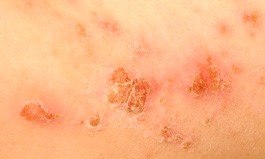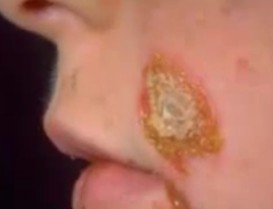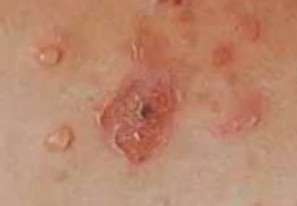Infantigo, also referred to as impetigo or school sores, is a bacterial infection that is caused by staphylococcus aureus. It is seen on face and areas around the mouth and nose. Infantigo appears as crusted lesion with a honey-like coloring. This condition is regarded as highly contagious skin infection. It is common in children. In rare circumstances, it may be caused by another strain of bacteria known as streptococcus pyogenes.
The first sign of infantigo is a patch of an itchy red skin. There are two types of infantigo and one is non-bullous impetigo also known as impetigo contagiosa. This tends to cause sores, which rapidly burst and leave a crust that appears yellow. It is the most prevalent of the two. The second type is bullous impetigo, which causes painless and large fluid filled blisters.
Impetigo is likely to develop in children who are aged between two and four years, but it can also affect people of all ages. Although is rarely a serious disease and resolves on its own, however, when complications occur, patients may be treated using antibiotics.
Causes of infantigo
Impetigo is caused by strains of bacterial mainly two strains. The bacterial may enter the skin through open areas such as wounds or insect bites. The bacteria is found living naturally on skin without causing problems. However, when the skin raptures or is exposed, it may enter and cause an infection. Inside the body, the bacteria produce toxins, which split the skin and cause rashes.
The first symptom of infantigo is the broken skin. The two kinds of bacteria that are associated with the cause of infantigo are strep or streptococcus and staph or staphylococcus. These bacteria can enter the body after the skin has been irritated or injured.
When a person has skin problems like insect bites, poison ivy, cuts, burns, eczema, or some other kinds of trauma, it may expose the inside of skin or dermis. The bacteria find their way into tissue of skin where they cause splitting open of the skin. Children may also get this infection after having allergies or cold, which makes the skin found under the nose to be raw.
Symptoms of infantigo/impetigo
An adult or child may have infantigo if they develop sores on skin in areas around the mouth and nose. The sores may transform and develop into small red spots before they change to blister form, which breaks open. Although these sores are not typically painful, they might become itchy. The itching may cause one to scratch the skin further damaging it and exposing themselves to more infections.
A person who develops sores that ooze fluids and they look crusty may also be having a symptom of infantigo. The sores may look as though they are coated with honey or some brown sugar. Sores that increase in number and size, and they are as large as a coin or as small as a pimple may show possible sign of infantigo.
The first stage of infantigo is a skin that has characteristically discolored red sore. The sore may begin 4 to 10 days after one has been exposed to contagious form of infantigo. Later on, the sores transform to blisters that are filled with fluid. The blisters are thin and they can rapture easily. Often, they ooze and weep, and the fluid inside them is usually straw colored.
The crust stage is where the blisters rapture and form a crust. This crust is honey colored, and it tends to dry up and disappear on its own. A fever may not necessarily accompany this infection. The rash may be itchy and with some mild pain. Once the rash has disappear, there are no scars left on skin.
Treatment
The diagnosis of impetigo is done through physical examination of skin. The characteristic look of the lesions may help determine whether it is an infantigo infection. Infantigo can spread among people in family and schools. This may be attributed by the increased contact between people. It can also spread by using personal care products and items like towels.
Therefore, it is important that people maintain personal hygiene and care if there is a member of family or a schoolchild affected. When the condition is causing itching, topical application medicines may be applied. This helps in easing the itchy skin. Usually, the common way of treating this condition is by using oral and topical antibiotics.
There may also be home remedies that can help in treatment to easy the discomforts. Otherwise, the condition can subside and disappear on its own without causing further damage. People should ensure that they control its spread by avoiding contact and sharing of items. Those who have the condition can keep their fingernails cut short so that they avoid scratching the skin. Scratching the skin can spread the lesions affect more parts of the body.




Где Вы ищите свежие новости?
Лично я читаю и доверяю газете https://www.ukr.net/.
Это единственный источник свежих и независимых новостей.
Рекомендую и Вам